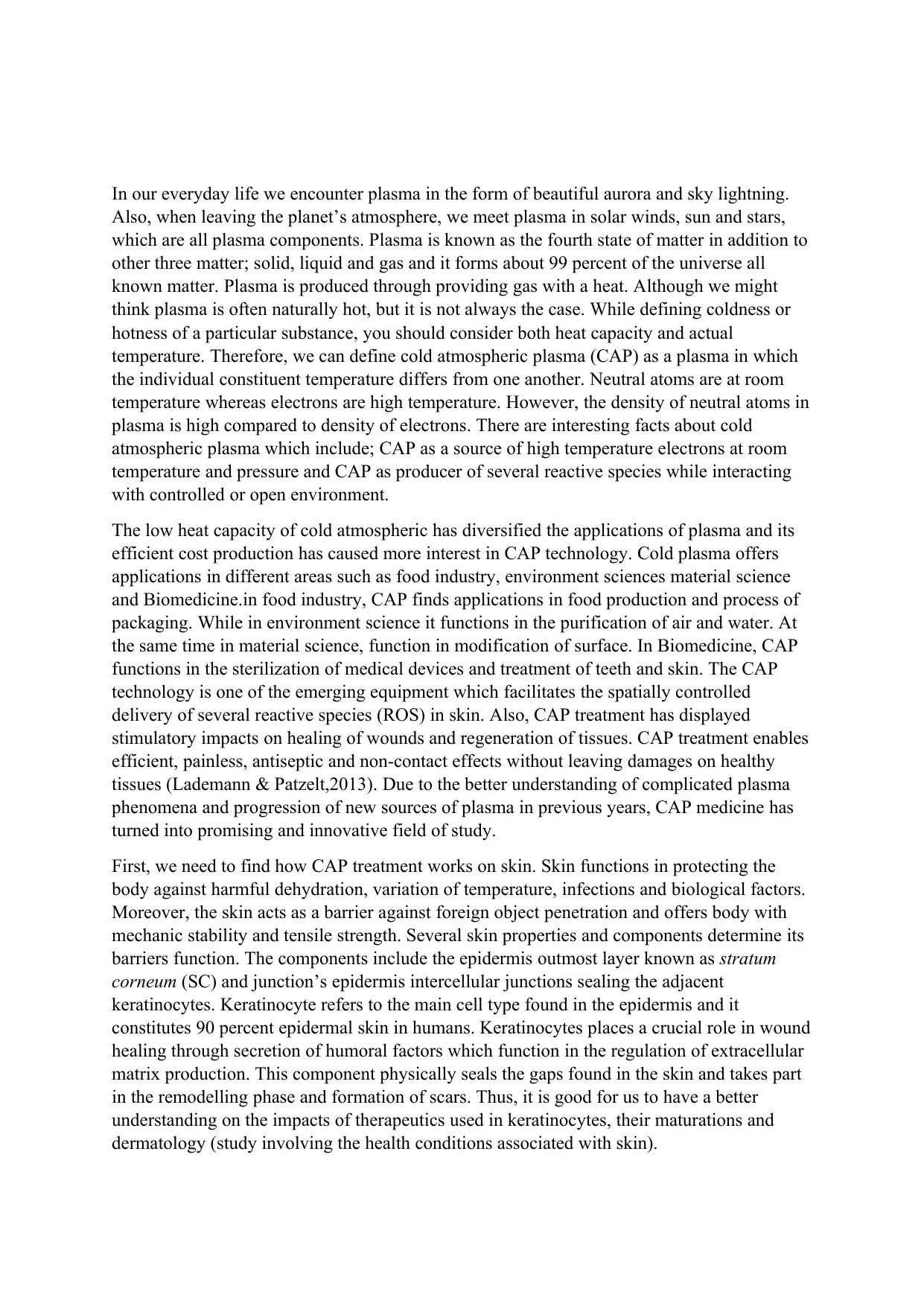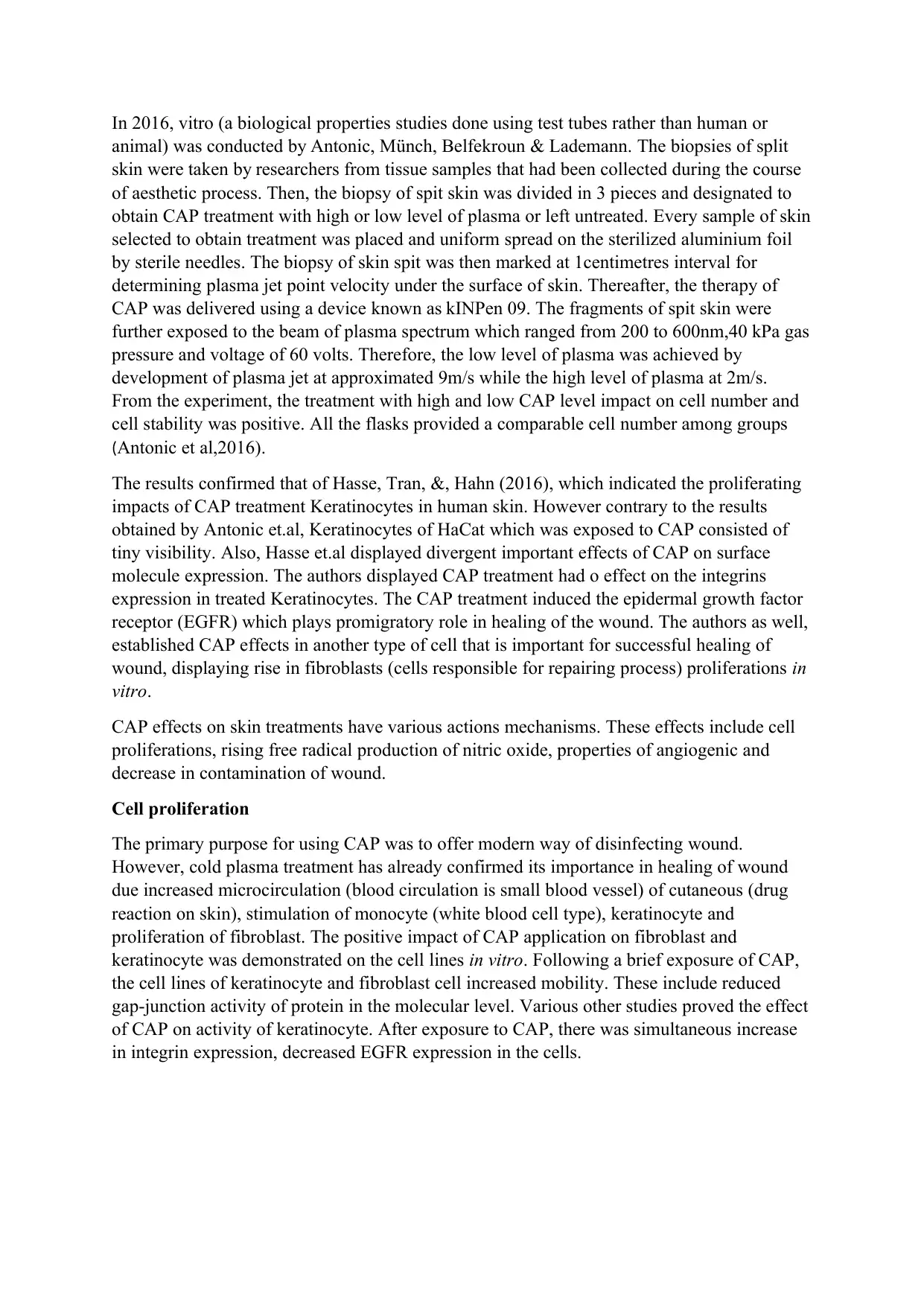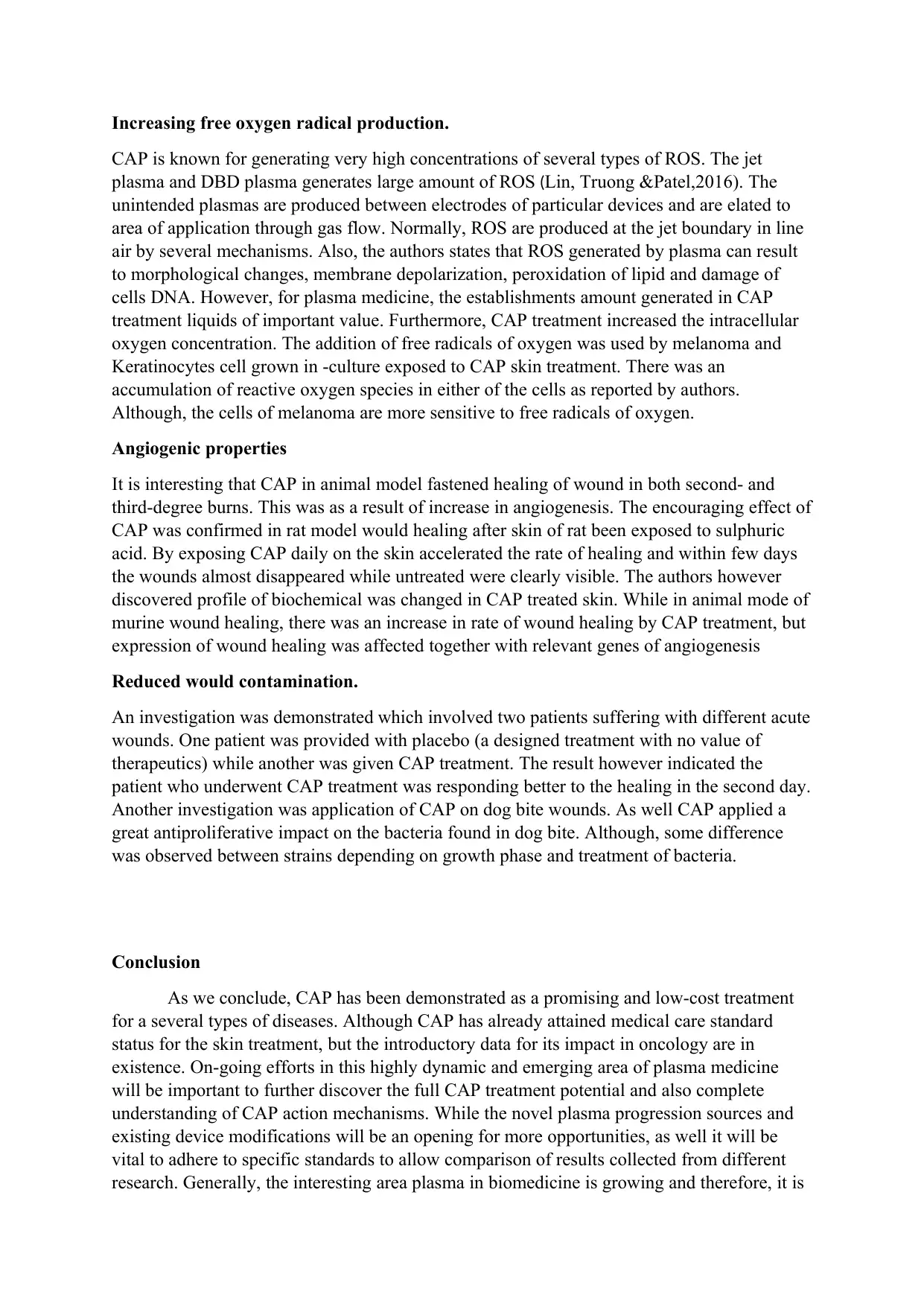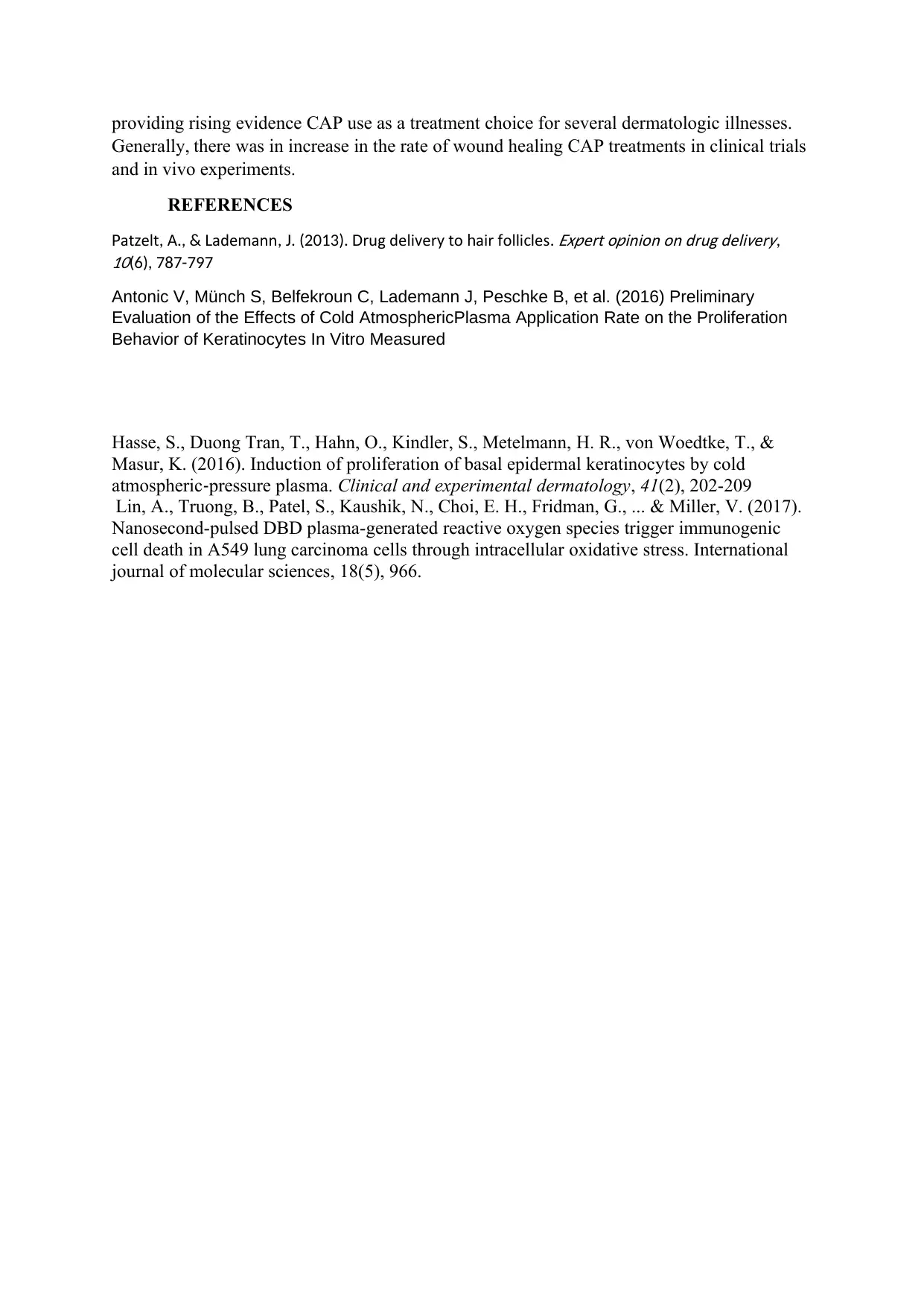Detailed Analysis: Cold Atmospheric Plasma (CAP) Treatment on Skin
VerifiedAdded on 2021/11/17
|4
|1965
|178
Report
AI Summary
This report explores the application of Cold Atmospheric Plasma (CAP) in skin treatment, examining its effects on cell proliferation, angiogenesis, and wound healing. It delves into the mechanisms by which CAP, a non-thermal plasma, interacts with skin cells, particularly keratinocytes, and generates reactive oxygen species (ROS). The report reviews experimental evidence, including in vitro studies and clinical trials, demonstrating CAP's potential to accelerate wound healing, reduce wound contamination, and stimulate tissue regeneration. It also discusses the angiogenic properties of CAP and its impact on the production of nitric oxide. The research presented highlights CAP as a promising, low-cost treatment option for various dermatological conditions, with ongoing efforts aimed at fully understanding its action mechanisms and expanding its applications in biomedicine.

In our everyday life we encounter plasma in the form of beautiful aurora and sky lightning.
Also, when leaving the planet’s atmosphere, we meet plasma in solar winds, sun and stars,
which are all plasma components. Plasma is known as the fourth state of matter in addition to
other three matter; solid, liquid and gas and it forms about 99 percent of the universe all
known matter. Plasma is produced through providing gas with a heat. Although we might
think plasma is often naturally hot, but it is not always the case. While defining coldness or
hotness of a particular substance, you should consider both heat capacity and actual
temperature. Therefore, we can define cold atmospheric plasma (CAP) as a plasma in which
the individual constituent temperature differs from one another. Neutral atoms are at room
temperature whereas electrons are high temperature. However, the density of neutral atoms in
plasma is high compared to density of electrons. There are interesting facts about cold
atmospheric plasma which include; CAP as a source of high temperature electrons at room
temperature and pressure and CAP as producer of several reactive species while interacting
with controlled or open environment.
The low heat capacity of cold atmospheric has diversified the applications of plasma and its
efficient cost production has caused more interest in CAP technology. Cold plasma offers
applications in different areas such as food industry, environment sciences material science
and Biomedicine.in food industry, CAP finds applications in food production and process of
packaging. While in environment science it functions in the purification of air and water. At
the same time in material science, function in modification of surface. In Biomedicine, CAP
functions in the sterilization of medical devices and treatment of teeth and skin. The CAP
technology is one of the emerging equipment which facilitates the spatially controlled
delivery of several reactive species (ROS) in skin. Also, CAP treatment has displayed
stimulatory impacts on healing of wounds and regeneration of tissues. CAP treatment enables
efficient, painless, antiseptic and non-contact effects without leaving damages on healthy
tissues (Lademann & Patzelt,2013). Due to the better understanding of complicated plasma
phenomena and progression of new sources of plasma in previous years, CAP medicine has
turned into promising and innovative field of study.
First, we need to find how CAP treatment works on skin. Skin functions in protecting the
body against harmful dehydration, variation of temperature, infections and biological factors.
Moreover, the skin acts as a barrier against foreign object penetration and offers body with
mechanic stability and tensile strength. Several skin properties and components determine its
barriers function. The components include the epidermis outmost layer known as stratum
corneum (SC) and junction’s epidermis intercellular junctions sealing the adjacent
keratinocytes. Keratinocyte refers to the main cell type found in the epidermis and it
constitutes 90 percent epidermal skin in humans. Keratinocytes places a crucial role in wound
healing through secretion of humoral factors which function in the regulation of extracellular
matrix production. This component physically seals the gaps found in the skin and takes part
in the remodelling phase and formation of scars. Thus, it is good for us to have a better
understanding on the impacts of therapeutics used in keratinocytes, their maturations and
dermatology (study involving the health conditions associated with skin).
Also, when leaving the planet’s atmosphere, we meet plasma in solar winds, sun and stars,
which are all plasma components. Plasma is known as the fourth state of matter in addition to
other three matter; solid, liquid and gas and it forms about 99 percent of the universe all
known matter. Plasma is produced through providing gas with a heat. Although we might
think plasma is often naturally hot, but it is not always the case. While defining coldness or
hotness of a particular substance, you should consider both heat capacity and actual
temperature. Therefore, we can define cold atmospheric plasma (CAP) as a plasma in which
the individual constituent temperature differs from one another. Neutral atoms are at room
temperature whereas electrons are high temperature. However, the density of neutral atoms in
plasma is high compared to density of electrons. There are interesting facts about cold
atmospheric plasma which include; CAP as a source of high temperature electrons at room
temperature and pressure and CAP as producer of several reactive species while interacting
with controlled or open environment.
The low heat capacity of cold atmospheric has diversified the applications of plasma and its
efficient cost production has caused more interest in CAP technology. Cold plasma offers
applications in different areas such as food industry, environment sciences material science
and Biomedicine.in food industry, CAP finds applications in food production and process of
packaging. While in environment science it functions in the purification of air and water. At
the same time in material science, function in modification of surface. In Biomedicine, CAP
functions in the sterilization of medical devices and treatment of teeth and skin. The CAP
technology is one of the emerging equipment which facilitates the spatially controlled
delivery of several reactive species (ROS) in skin. Also, CAP treatment has displayed
stimulatory impacts on healing of wounds and regeneration of tissues. CAP treatment enables
efficient, painless, antiseptic and non-contact effects without leaving damages on healthy
tissues (Lademann & Patzelt,2013). Due to the better understanding of complicated plasma
phenomena and progression of new sources of plasma in previous years, CAP medicine has
turned into promising and innovative field of study.
First, we need to find how CAP treatment works on skin. Skin functions in protecting the
body against harmful dehydration, variation of temperature, infections and biological factors.
Moreover, the skin acts as a barrier against foreign object penetration and offers body with
mechanic stability and tensile strength. Several skin properties and components determine its
barriers function. The components include the epidermis outmost layer known as stratum
corneum (SC) and junction’s epidermis intercellular junctions sealing the adjacent
keratinocytes. Keratinocyte refers to the main cell type found in the epidermis and it
constitutes 90 percent epidermal skin in humans. Keratinocytes places a crucial role in wound
healing through secretion of humoral factors which function in the regulation of extracellular
matrix production. This component physically seals the gaps found in the skin and takes part
in the remodelling phase and formation of scars. Thus, it is good for us to have a better
understanding on the impacts of therapeutics used in keratinocytes, their maturations and
dermatology (study involving the health conditions associated with skin).
Paraphrase This Document
Need a fresh take? Get an instant paraphrase of this document with our AI Paraphraser

In 2016, vitro (a biological properties studies done using test tubes rather than human or
animal) was conducted by Antonic, Münch, Belfekroun & Lademann. The biopsies of split
skin were taken by researchers from tissue samples that had been collected during the course
of aesthetic process. Then, the biopsy of spit skin was divided in 3 pieces and designated to
obtain CAP treatment with high or low level of plasma or left untreated. Every sample of skin
selected to obtain treatment was placed and uniform spread on the sterilized aluminium foil
by sterile needles. The biopsy of skin spit was then marked at 1centimetres interval for
determining plasma jet point velocity under the surface of skin. Thereafter, the therapy of
CAP was delivered using a device known as kINPen 09. The fragments of spit skin were
further exposed to the beam of plasma spectrum which ranged from 200 to 600nm,40 kPa gas
pressure and voltage of 60 volts. Therefore, the low level of plasma was achieved by
development of plasma jet at approximated 9m/s while the high level of plasma at 2m/s.
From the experiment, the treatment with high and low CAP level impact on cell number and
cell stability was positive. All the flasks provided a comparable cell number among groups
(Antonic et al,2016).
The results confirmed that of Hasse, Tran, &, Hahn (2016), which indicated the proliferating
impacts of CAP treatment Keratinocytes in human skin. However contrary to the results
obtained by Antonic et.al, Keratinocytes of HaCat which was exposed to CAP consisted of
tiny visibility. Also, Hasse et.al displayed divergent important effects of CAP on surface
molecule expression. The authors displayed CAP treatment had o effect on the integrins
expression in treated Keratinocytes. The CAP treatment induced the epidermal growth factor
receptor (EGFR) which plays promigratory role in healing of the wound. The authors as well,
established CAP effects in another type of cell that is important for successful healing of
wound, displaying rise in fibroblasts (cells responsible for repairing process) proliferations in
vitro.
CAP effects on skin treatments have various actions mechanisms. These effects include cell
proliferations, rising free radical production of nitric oxide, properties of angiogenic and
decrease in contamination of wound.
Cell proliferation
The primary purpose for using CAP was to offer modern way of disinfecting wound.
However, cold plasma treatment has already confirmed its importance in healing of wound
due increased microcirculation (blood circulation is small blood vessel) of cutaneous (drug
reaction on skin), stimulation of monocyte (white blood cell type), keratinocyte and
proliferation of fibroblast. The positive impact of CAP application on fibroblast and
keratinocyte was demonstrated on the cell lines in vitro. Following a brief exposure of CAP,
the cell lines of keratinocyte and fibroblast cell increased mobility. These include reduced
gap-junction activity of protein in the molecular level. Various other studies proved the effect
of CAP on activity of keratinocyte. After exposure to CAP, there was simultaneous increase
in integrin expression, decreased EGFR expression in the cells.
animal) was conducted by Antonic, Münch, Belfekroun & Lademann. The biopsies of split
skin were taken by researchers from tissue samples that had been collected during the course
of aesthetic process. Then, the biopsy of spit skin was divided in 3 pieces and designated to
obtain CAP treatment with high or low level of plasma or left untreated. Every sample of skin
selected to obtain treatment was placed and uniform spread on the sterilized aluminium foil
by sterile needles. The biopsy of skin spit was then marked at 1centimetres interval for
determining plasma jet point velocity under the surface of skin. Thereafter, the therapy of
CAP was delivered using a device known as kINPen 09. The fragments of spit skin were
further exposed to the beam of plasma spectrum which ranged from 200 to 600nm,40 kPa gas
pressure and voltage of 60 volts. Therefore, the low level of plasma was achieved by
development of plasma jet at approximated 9m/s while the high level of plasma at 2m/s.
From the experiment, the treatment with high and low CAP level impact on cell number and
cell stability was positive. All the flasks provided a comparable cell number among groups
(Antonic et al,2016).
The results confirmed that of Hasse, Tran, &, Hahn (2016), which indicated the proliferating
impacts of CAP treatment Keratinocytes in human skin. However contrary to the results
obtained by Antonic et.al, Keratinocytes of HaCat which was exposed to CAP consisted of
tiny visibility. Also, Hasse et.al displayed divergent important effects of CAP on surface
molecule expression. The authors displayed CAP treatment had o effect on the integrins
expression in treated Keratinocytes. The CAP treatment induced the epidermal growth factor
receptor (EGFR) which plays promigratory role in healing of the wound. The authors as well,
established CAP effects in another type of cell that is important for successful healing of
wound, displaying rise in fibroblasts (cells responsible for repairing process) proliferations in
vitro.
CAP effects on skin treatments have various actions mechanisms. These effects include cell
proliferations, rising free radical production of nitric oxide, properties of angiogenic and
decrease in contamination of wound.
Cell proliferation
The primary purpose for using CAP was to offer modern way of disinfecting wound.
However, cold plasma treatment has already confirmed its importance in healing of wound
due increased microcirculation (blood circulation is small blood vessel) of cutaneous (drug
reaction on skin), stimulation of monocyte (white blood cell type), keratinocyte and
proliferation of fibroblast. The positive impact of CAP application on fibroblast and
keratinocyte was demonstrated on the cell lines in vitro. Following a brief exposure of CAP,
the cell lines of keratinocyte and fibroblast cell increased mobility. These include reduced
gap-junction activity of protein in the molecular level. Various other studies proved the effect
of CAP on activity of keratinocyte. After exposure to CAP, there was simultaneous increase
in integrin expression, decreased EGFR expression in the cells.

Increasing free oxygen radical production.
CAP is known for generating very high concentrations of several types of ROS. The jet
plasma and DBD plasma generates large amount of ROS (Lin, Truong &Patel,2016). The
unintended plasmas are produced between electrodes of particular devices and are elated to
area of application through gas flow. Normally, ROS are produced at the jet boundary in line
air by several mechanisms. Also, the authors states that ROS generated by plasma can result
to morphological changes, membrane depolarization, peroxidation of lipid and damage of
cells DNA. However, for plasma medicine, the establishments amount generated in CAP
treatment liquids of important value. Furthermore, CAP treatment increased the intracellular
oxygen concentration. The addition of free radicals of oxygen was used by melanoma and
Keratinocytes cell grown in -culture exposed to CAP skin treatment. There was an
accumulation of reactive oxygen species in either of the cells as reported by authors.
Although, the cells of melanoma are more sensitive to free radicals of oxygen.
Angiogenic properties
It is interesting that CAP in animal model fastened healing of wound in both second- and
third-degree burns. This was as a result of increase in angiogenesis. The encouraging effect of
CAP was confirmed in rat model would healing after skin of rat been exposed to sulphuric
acid. By exposing CAP daily on the skin accelerated the rate of healing and within few days
the wounds almost disappeared while untreated were clearly visible. The authors however
discovered profile of biochemical was changed in CAP treated skin. While in animal mode of
murine wound healing, there was an increase in rate of wound healing by CAP treatment, but
expression of wound healing was affected together with relevant genes of angiogenesis
Reduced would contamination.
An investigation was demonstrated which involved two patients suffering with different acute
wounds. One patient was provided with placebo (a designed treatment with no value of
therapeutics) while another was given CAP treatment. The result however indicated the
patient who underwent CAP treatment was responding better to the healing in the second day.
Another investigation was application of CAP on dog bite wounds. As well CAP applied a
great antiproliferative impact on the bacteria found in dog bite. Although, some difference
was observed between strains depending on growth phase and treatment of bacteria.
Conclusion
As we conclude, CAP has been demonstrated as a promising and low-cost treatment
for a several types of diseases. Although CAP has already attained medical care standard
status for the skin treatment, but the introductory data for its impact in oncology are in
existence. On-going efforts in this highly dynamic and emerging area of plasma medicine
will be important to further discover the full CAP treatment potential and also complete
understanding of CAP action mechanisms. While the novel plasma progression sources and
existing device modifications will be an opening for more opportunities, as well it will be
vital to adhere to specific standards to allow comparison of results collected from different
research. Generally, the interesting area plasma in biomedicine is growing and therefore, it is
CAP is known for generating very high concentrations of several types of ROS. The jet
plasma and DBD plasma generates large amount of ROS (Lin, Truong &Patel,2016). The
unintended plasmas are produced between electrodes of particular devices and are elated to
area of application through gas flow. Normally, ROS are produced at the jet boundary in line
air by several mechanisms. Also, the authors states that ROS generated by plasma can result
to morphological changes, membrane depolarization, peroxidation of lipid and damage of
cells DNA. However, for plasma medicine, the establishments amount generated in CAP
treatment liquids of important value. Furthermore, CAP treatment increased the intracellular
oxygen concentration. The addition of free radicals of oxygen was used by melanoma and
Keratinocytes cell grown in -culture exposed to CAP skin treatment. There was an
accumulation of reactive oxygen species in either of the cells as reported by authors.
Although, the cells of melanoma are more sensitive to free radicals of oxygen.
Angiogenic properties
It is interesting that CAP in animal model fastened healing of wound in both second- and
third-degree burns. This was as a result of increase in angiogenesis. The encouraging effect of
CAP was confirmed in rat model would healing after skin of rat been exposed to sulphuric
acid. By exposing CAP daily on the skin accelerated the rate of healing and within few days
the wounds almost disappeared while untreated were clearly visible. The authors however
discovered profile of biochemical was changed in CAP treated skin. While in animal mode of
murine wound healing, there was an increase in rate of wound healing by CAP treatment, but
expression of wound healing was affected together with relevant genes of angiogenesis
Reduced would contamination.
An investigation was demonstrated which involved two patients suffering with different acute
wounds. One patient was provided with placebo (a designed treatment with no value of
therapeutics) while another was given CAP treatment. The result however indicated the
patient who underwent CAP treatment was responding better to the healing in the second day.
Another investigation was application of CAP on dog bite wounds. As well CAP applied a
great antiproliferative impact on the bacteria found in dog bite. Although, some difference
was observed between strains depending on growth phase and treatment of bacteria.
Conclusion
As we conclude, CAP has been demonstrated as a promising and low-cost treatment
for a several types of diseases. Although CAP has already attained medical care standard
status for the skin treatment, but the introductory data for its impact in oncology are in
existence. On-going efforts in this highly dynamic and emerging area of plasma medicine
will be important to further discover the full CAP treatment potential and also complete
understanding of CAP action mechanisms. While the novel plasma progression sources and
existing device modifications will be an opening for more opportunities, as well it will be
vital to adhere to specific standards to allow comparison of results collected from different
research. Generally, the interesting area plasma in biomedicine is growing and therefore, it is
⊘ This is a preview!⊘
Do you want full access?
Subscribe today to unlock all pages.

Trusted by 1+ million students worldwide

providing rising evidence CAP use as a treatment choice for several dermatologic illnesses.
Generally, there was in increase in the rate of wound healing CAP treatments in clinical trials
and in vivo experiments.
REFERENCES
at elt ade ann rug deli er to air folli lesP z , A., & L m , J. (2013). D v y h c .
ert o inion on drug deli er
Exp p
v y,10(6), 787-797
Antonic V, Münch S, Belfekroun C, Lademann J, Peschke B, et al. (2016) Preliminary
Evaluation of the Effects of Cold AtmosphericPlasma Application Rate on the Proliferation
Behavior of Keratinocytes In Vitro Measured
Hasse, S., Duong Tran, T., Hahn, O., Kindler, S., Metelmann, H. R., von Woedtke, T., &
Masur, K. (2016). Induction of proliferation of basal epidermal keratinocytes by cold
atmospheric‐pressure plasma. Clinical and experimental dermatology, 41(2), 202-209
Lin, A., Truong, B., Patel, S., Kaushik, N., Choi, E. H., Fridman, G., ... & Miller, V. (2017).
Nanosecond-pulsed DBD plasma-generated reactive oxygen species trigger immunogenic
cell death in A549 lung carcinoma cells through intracellular oxidative stress. International
journal of molecular sciences, 18(5), 966.
Generally, there was in increase in the rate of wound healing CAP treatments in clinical trials
and in vivo experiments.
REFERENCES
at elt ade ann rug deli er to air folli lesP z , A., & L m , J. (2013). D v y h c .
ert o inion on drug deli er
Exp p
v y,10(6), 787-797
Antonic V, Münch S, Belfekroun C, Lademann J, Peschke B, et al. (2016) Preliminary
Evaluation of the Effects of Cold AtmosphericPlasma Application Rate on the Proliferation
Behavior of Keratinocytes In Vitro Measured
Hasse, S., Duong Tran, T., Hahn, O., Kindler, S., Metelmann, H. R., von Woedtke, T., &
Masur, K. (2016). Induction of proliferation of basal epidermal keratinocytes by cold
atmospheric‐pressure plasma. Clinical and experimental dermatology, 41(2), 202-209
Lin, A., Truong, B., Patel, S., Kaushik, N., Choi, E. H., Fridman, G., ... & Miller, V. (2017).
Nanosecond-pulsed DBD plasma-generated reactive oxygen species trigger immunogenic
cell death in A549 lung carcinoma cells through intracellular oxidative stress. International
journal of molecular sciences, 18(5), 966.
1 out of 4
Your All-in-One AI-Powered Toolkit for Academic Success.
+13062052269
info@desklib.com
Available 24*7 on WhatsApp / Email
![[object Object]](/_next/static/media/star-bottom.7253800d.svg)
Unlock your academic potential
Copyright © 2020–2025 A2Z Services. All Rights Reserved. Developed and managed by ZUCOL.